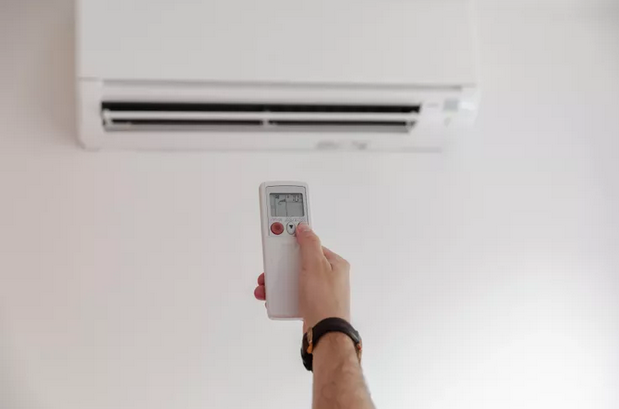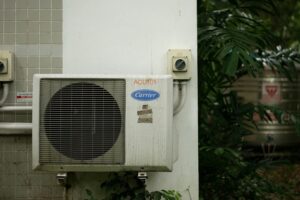Home air conditioners come in several types, ranging from large central systems driven by outdoor compressors to small plug-in units that stand on the floor or mount in a window. No matter which form they take, air-conditioning systems have similar working components, including a refrigerant, a compressor, condenser coils, an expansion valve, and evaporator coils. All of these work together to transfer heat and moisture from the inside of your home to the outside.
Below, we’ll break down the ins and outs of each type of home air conditioner to help you determine which is right for your space.
- Window Air Conditioners
:max_bytes(150000):strip_icc():format(webp)/how-types-of-air-conditioning-systems-work-1824734-window-3d05b1c7d7c24c7cb9edd236e35aae8f.jpeg) The Spruce / Letícia Almeida
The Spruce / Letícia Almeida- Best for: Cooling a single room to a small home
A window air conditioner is technically called a “unitary” air-conditioning system and consists of a self-contained air-conditioning unit that is placed in a window or, less commonly, through a hole in an exterior wall. A window air conditioner contains all the refrigeration components in one compact box. It ejects heat out through condenser coils located on the outdoor side of the appliance. And it blows cooled air into the room on the indoor side where the evaporator coils are located. Room moisture that condenses on the evaporator coils generally drips to the ground from a tray located on the underside of the appliance. This is why it is important that a window air conditioner is installed so it tilts very slightly toward the outdoor side. Tilted the wrong way, some air conditioners might drip water onto the floor inside the house. Window air conditioners come in many sizes to cool any space from a single room up to an entire floor. A large window air conditioner might be able to cool an entire small home, especially if it’s a single-story home. And it’s an economical choice with easy installation. - Portable Air Conditioners
:max_bytes(150000):strip_icc():format(webp)/GettyImages-1350115653-2209264ba1df481e8b900b5e673b5b9f.jpg) Icy Macload / Getty Images
Icy Macload / Getty Images- Best for: Rooms under 500 square feet
A portable air conditioner is another type of unitary air-conditioning system. It consists of a mobile, self-contained air-conditioning unit that is placed on the floor inside a room. It discharges exhaust heat using a hose vent through an exterior wall or window vent. Like a window air conditioner, both evaporator coils and condenser coils are located in the same box, which is one reason these units are a bit noisier than other types of AC systems. Portable air conditioners are typically used for rooms under 500 square feet, and they’re an economical choice. Many people use them for temporary space cooling or wherever it’s not practical to install a window-mounted unit. Because the portable unit sits indoors, its evaporator fan runs fairly constantly to evaporate the condensed moisture that collects within the unit. Units also might have a reservoir to capture condensed water, which needs to be emptied periodically. This is quite different from a window-mounted unit, where condensed moisture simply drips onto the ground. - Split (Ductless) Air Conditioners
:max_bytes(150000):strip_icc():format(webp)/how-types-of-air-conditioning-systems-work-1824734-ductless-460683a6b30140cf966bfbe91ed30a78.jpg) The Spruce / Letícia Almeida
The Spruce / Letícia Almeida- Best for: Homes without an HVAC system
The split system—also called ductless or “mini-split”—breaks the air-conditioning system into two packages, or terminal units. The condensing unit is located on the building’s exterior and includes the compressor, condenser, and condenser fan. The evaporative unit is located on the interior and handles the air cooling and distribution. This is usually a rectangular box unit mounted high on an interior wall and contains a circulation fan, expansion valve, and evaporator coil. Refrigerant tubing passes through the wall between the condensing and evaporative units. A secondary tube running parallel to the refrigerant tubing drains away water that condenses from the indoor evaporator coils. The split system is commonly found in homes as well as hotels and other multi-unit buildings. It has become an increasingly popular option for homes without an HVAC system, such as those with hot-water or steam radiator heating or electric heating. It’s cheaper to install than a whole-home HVAC system. And most split air conditioners are also heat pumps and therefore offer heating as well as cooling functions. - Central Air Conditioning
:max_bytes(150000):strip_icc():format(webp)/GettyImages-1356788245-265a3e7f894b42e287507aa0a2e16d41.jpg) Hildegarde / Getty Images
Hildegarde / Getty Images- Best for: Effective whole-home cooling
A central air-conditioning system is the largest and most expensive type of conventional air conditioner. Like a split system, a central system is made up of two units—the condensing unit and the evaporative unit—that are connected to each other by refrigerant tubing.
The condensing unit is a large, boxy outdoor appliance that contains the compressor, condensing coils, and condensing fan. The evaporative unit typically sits in the plenum (the large central chamber between the furnace and the duct system) of your furnace. This means the air conditioning uses the same ductwork and blower fan as your heating system. Within the plenum, the evaporative unit consists of the evaporator coil and expansion valve. Condensed moisture on the evaporator coils is usually drained away through a tube running to a floor drain.
Central air conditioners are typically the most effective type of air conditioner for cooling entire homes. When installing a new central system, the primary consideration is making sure the system is sized appropriately for your home. If a system is too large, it won’t perform well and won’t adequately dehumidify the interior air. If it’s too small, it won’t cool adequately. Proper maintenance of a central air conditioning system is also important and often requires a professional.
Choosing a Home Air Conditioner
The size and type of space you’re looking to cool will be one of the most important factors when determining which home air conditioner is right for you. For instance, if you just need to cool one room, a portable or window unit will likely suffice. Likewise, if you’re a renter and can’t install anything permanent, you also might need to go with a portable or window unit.
Even if you own your home, cost will likely be a factor. For example, if you don’t want to pay to have a full HVAC system installed, you might be better off with a less expensive ductless system.
Text taken from: https://www.thespruce.com






